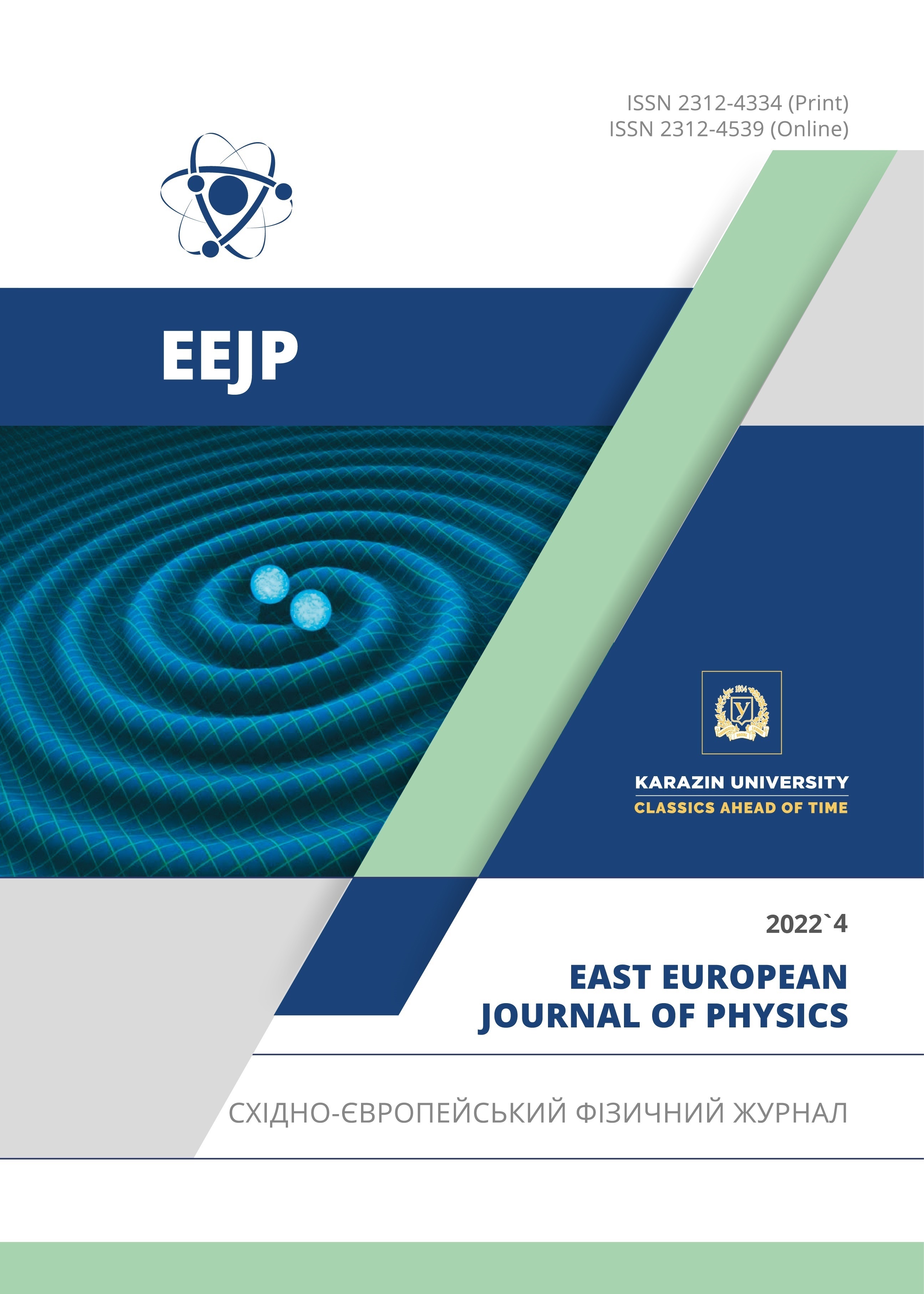Дослідження фотонейтронних реакцій за допомогою статистичного аналізу
Анотація
Добре відомими вхідними даними для визначення перетину реакції є щільність ядерного рівня (NLD) і силові функції γ‑променів. У цій роботі за допомогою останньої версії комп’ютерного коду TALYS проаналізовано вплив силових функцій γ-випромінювання та моделей NLD на фотонейтронні реакції ізотопів 76,77,78Se. Для силових функцій γ-променів у розрахунках використовуються макроскопічні та мікроскопічні параметри, доступні в TALYS. Моделі функції сили Копекі-Ула та Брінка Акселя як макроскопічні варіанти, таблиці Хартрі-Фока BCS, таблиці Хартрі-Фока Боголюбова та гібридна модель Горілі як мікроскопічні варіанти. Проведено статистичний аналіз для визначення силової функції γ-променів, яка досить добре відтворює експериментальні дані. Потім розрахунки поперечного перерізу фотонейтронів переробляються за допомогою визначеної функції сили γ-випромінювання за допомогою моделей NLD. В NLD розрахунках краще використовувати модель постійної температури (CTM), модель газу Фермі зі зсувом назад (BSFGM) і узагальнену надтекучу модель (GSM). Прогнози порівнюються між собою та наявними експериментальними даними. Для отримання всіх експериментальних даних використовується бібліотека EXFOR.
Завантаження
Посилання
A. Koning, S. Hilaire, and S. Goriely, TALYS A Nuclear Reaction Program, User Manual, The Netherlans (2022).
M. Herman, et al., EMPIRE, Rivoli Moduler System for Nuclear Reaction Calculations and Nuclear Data Evaluation, User’s Manual, National Nuclear Data Center (2012).
D. Canbula, International Journal of Pure and Applied Sciences, 7, 314 (2021). https://doi.org/10.29132/ijpas.879068
B. Canbula, Süleyman Demirel Üniversitesi Fen Bilimleri Enstitüsü Dergisi 24, 138 (2020). https://doi.org/10.19113/sdufenbed.639828
İ.H. Sarpün, H. Özdoğan, K. Taşdöven, H.A. Yalim, and A. Kaplan, Modern Physics Letters A, 34, 1950210 (2019).
P.V. Cuong, T.D. Thiep, L.T. Anh, T.T. An, B.M. Hue, K.T. Thanh, N.H. Tan, et al, Instruments and Methods in Physics Research Section B: Beam Interactions with Materials and Atoms, 479, 68 (2020). https://doi.org/10.1016/j.nimb.2020.06.011
J. Arends, J. Eyink, A. Hegerath, K. G. Hilger, B. Mecking, G. Nöldeke, and H. Rost, Physics Letters B, 98, 423 (1981). https://doi.org/10.1016/0370-2693(81)90444-5
E. Vagena, and S. Stoulos, Nuclear Physics A, 957, 259 (2017). https://doi.org/10.1016/j.nuclphysa.2016.09.007
F. Kitatani, H. Harada, S. Goko, H. Utsunomiya, H. Akimune, H. Toyokawa, and K. Yamada, Journal of nuclear science and technology, 48, 1017 (2011). https://doi.org/10.1080/18811248.2011.9711787
A.M. Goryachev, Issues of theoretical and nuclear physics, 8, 121 (1982). (in Russian)
D. Canbula, and B. Canbula, Nuclear Physics and Atomic Energy, 23, 5 (2022). https://doi.org/10.15407/jnpae2022.01.005
D. Canbula, International Journal of Pure and Applied Sciences, 8, 173 (2022). https://doi.org/10.29132/ijpas.1081660
D. Canbula, Afyon Kocatepe Üniversitesi Fen Ve Mühendislik Bilimleri Dergisi, 22, 730 (2022). https://doi.org/10.35414/akufemubid.1097069
D. Canbula, Nuclear Instruments and Methods in Physics Research Section B: Beam Interactions with Materials and Atoms, 478, 229 (2020). https://doi.org/10.1016/j.nimb.2020.06.041
B. Canbula, D. Canbula, and H. Babacan, Physical Review C, 91, 044615 (2015). https://doi.org/10.1103/PhysRevC.91.044615
Y. Kucuk, M. B. Yücel, I. Boztosun, T.K. Zholdybayev, B. Canbula, Z. Mukan, and K.M. Ismailov, European Physical Journal A, Hadrons, and nuclei, 58, 97 (2022). https://doi.org/10.1140/epja/s10050-022-00740-8
K. Azhdarli, Y. Kucuk, B. Canbula, T. Zholdybayev, Z. Mukan, B. Emre, B.I. Boztosun, et al, in: Tenth AASPP Workshop on Asian Nuclear Reaction Database Development, (IAEA, Almaty, Kazakhstan, 2019), pp. 53.
B. Canbula, Nuclear Instruments and Methods in Physics Research Section B: Beam Interactions with Materials and Atoms, 391, 73 (2017). https://doi.org/10.1016/j.nimb.2016.11.006
B. Canbula, Celal Bayar University Journal of Science, 13, 445 (2017). https://doi.org/10.18466/cbayarfbe.319917
EXFOR, Brookhaven National Laboratory, National Nuclear Data Center, Database, https://www-nds.iaea.org/exfor/
D.M. Brink, Nuclear Physics, 4, 215 (1957). https://doi.org/10.1016/0029-5582(87)90021-6
P. Axel, Physical Review 126, 671 (1962). https://doi.org/10.1103/PhysRev.126.671
J. Kopecky, and M. Uhl, Physical Review C, 41, 1941 (1990). https://doi.org/10.1103/PhysRevC.41.1941
S. Goriely, S. Hilaire, A.J. Koning, M. Sin, and R. Capote, Physical Review C, 79, 024612 (2009). https://doi.org/10.1103/PhysRevC.79.024612
R. Capote, M. Herman, P. Obložinský, P.G. Young, S. Goriely, T. Belgya, A.V. Ignatyuk, et al, Nuclear Data Sheets, 110, 3107 (2009). https://doi.org/10.1016/j.nds.2009.10.004
H.A. Bethe, Reviews of Modern Physics, 9, 69 (1937). https://doi.org/10.1103/RevModPhys.9.69
A. Gilbert, and A.G.W. Cameron, Canadian Journal of Physics, 43, 1446 (1965). https://doi.org/10.1139/p65-139
W. Dilg, W. Schantl, H. Vonach, and M. Uhl, Nuclear Physics A, 217, 269 (1973). https://doi.org/10.1016/0375-9474(73)90196-6
A.V. Ignatyuk, K.K. Istekov, and G.N. Smirenkin, (Kernforschungszentrum Karlsruhe GmbH, Germany, 1979). https://inis.iaea.org/search/searchsinglerecord.aspx?recordsFor=SingleRecord&RN=11512726
Авторське право (c) 2022 Деніз Канбула, Бора Канбула

Цю роботу ліцензовано за Міжнародня ліцензія Creative Commons Attribution 4.0.
Автори, які публікуються у цьому журналі, погоджуються з наступними умовами:
- Автори залишають за собою право на авторство своєї роботи та передають журналу право першої публікації цієї роботи на умовах ліцензії Creative Commons Attribution License, котра дозволяє іншим особам вільно розповсюджувати опубліковану роботу з обов'язковим посиланням на авторів оригінальної роботи та першу публікацію роботи у цьому журналі.
- Автори мають право укладати самостійні додаткові угоди щодо неексклюзивного розповсюдження роботи у тому вигляді, в якому вона була опублікована цим журналом (наприклад, розміщувати роботу в електронному сховищі установи або публікувати у складі монографії), за умови збереження посилання на першу публікацію роботи у цьому журналі.
- Політика журналу дозволяє і заохочує розміщення авторами в мережі Інтернет (наприклад, у сховищах установ або на особистих веб-сайтах) рукопису роботи, як до подання цього рукопису до редакції, так і під час його редакційного опрацювання, оскільки це сприяє виникненню продуктивної наукової дискусії та позитивно позначається на оперативності та динаміці цитування опублікованої роботи (див. The Effect of Open Access).








